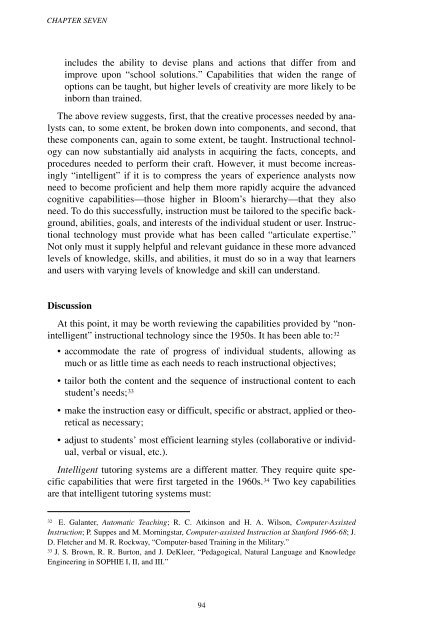Analytic Culture in the U.S. Intelligence Community (PDF) - CIA
Analytic Culture in the U.S. Intelligence Community (PDF) - CIA
Analytic Culture in the U.S. Intelligence Community (PDF) - CIA
You also want an ePaper? Increase the reach of your titles
YUMPU automatically turns print PDFs into web optimized ePapers that Google loves.
CHAPTER SEVEN<br />
<strong>in</strong>cludes <strong>the</strong> ability to devise plans and actions that differ from and<br />
improve upon “school solutions.” Capabilities that widen <strong>the</strong> range of<br />
options can be taught, but higher levels of creativity are more likely to be<br />
<strong>in</strong>born than tra<strong>in</strong>ed.<br />
The above review suggests, first, that <strong>the</strong> creative processes needed by analysts<br />
can, to some extent, be broken down <strong>in</strong>to components, and second, that<br />
<strong>the</strong>se components can, aga<strong>in</strong> to some extent, be taught. Instructional technology<br />
can now substantially aid analysts <strong>in</strong> acquir<strong>in</strong>g <strong>the</strong> facts, concepts, and<br />
procedures needed to perform <strong>the</strong>ir craft. However, it must become <strong>in</strong>creas<strong>in</strong>gly<br />
“<strong>in</strong>telligent” if it is to compress <strong>the</strong> years of experience analysts now<br />
need to become proficient and help <strong>the</strong>m more rapidly acquire <strong>the</strong> advanced<br />
cognitive capabilities—those higher <strong>in</strong> Bloom’s hierarchy—that <strong>the</strong>y also<br />
need. To do this successfully, <strong>in</strong>struction must be tailored to <strong>the</strong> specific background,<br />
abilities, goals, and <strong>in</strong>terests of <strong>the</strong> <strong>in</strong>dividual student or user. Instructional<br />
technology must provide what has been called “articulate expertise.”<br />
Not only must it supply helpful and relevant guidance <strong>in</strong> <strong>the</strong>se more advanced<br />
levels of knowledge, skills, and abilities, it must do so <strong>in</strong> a way that learners<br />
and users with vary<strong>in</strong>g levels of knowledge and skill can understand.<br />
Discussion<br />
At this po<strong>in</strong>t, it may be worth review<strong>in</strong>g <strong>the</strong> capabilities provided by “non<strong>in</strong>telligent”<br />
<strong>in</strong>structional technology s<strong>in</strong>ce <strong>the</strong> 1950s. It has been able to: 32<br />
• accommodate <strong>the</strong> rate of progress of <strong>in</strong>dividual students, allow<strong>in</strong>g as<br />
much or as little time as each needs to reach <strong>in</strong>structional objectives;<br />
• tailor both <strong>the</strong> content and <strong>the</strong> sequence of <strong>in</strong>structional content to each<br />
student’s needs; 33<br />
• make <strong>the</strong> <strong>in</strong>struction easy or difficult, specific or abstract, applied or <strong>the</strong>oretical<br />
as necessary;<br />
• adjust to students’ most efficient learn<strong>in</strong>g styles (collaborative or <strong>in</strong>dividual,<br />
verbal or visual, etc.).<br />
Intelligent tutor<strong>in</strong>g systems are a different matter. They require quite specific<br />
capabilities that were first targeted <strong>in</strong> <strong>the</strong> 1960s. 34 Two key capabilities<br />
are that <strong>in</strong>telligent tutor<strong>in</strong>g systems must:<br />
32<br />
E. Galanter, Automatic Teach<strong>in</strong>g; R. C. Atk<strong>in</strong>son and H. A. Wilson, Computer-Assisted<br />
Instruction; P. Suppes and M. Morn<strong>in</strong>gstar, Computer-assisted Instruction at Stanford 1966-68; J.<br />
D. Fletcher and M. R. Rockway, “Computer-based Tra<strong>in</strong><strong>in</strong>g <strong>in</strong> <strong>the</strong> Military.”<br />
33<br />
J. S. Brown, R. R. Burton, and J. DeKleer, “Pedagogical, Natural Language and Knowledge<br />
Eng<strong>in</strong>eer<strong>in</strong>g <strong>in</strong> SOPHIE I, II, and III.”<br />
94
















